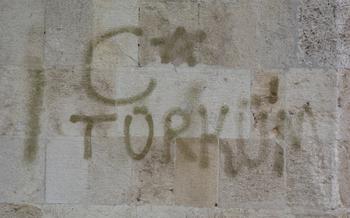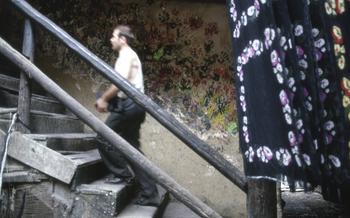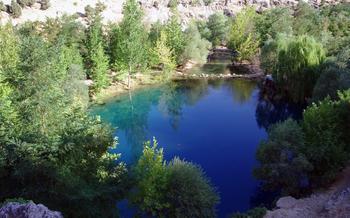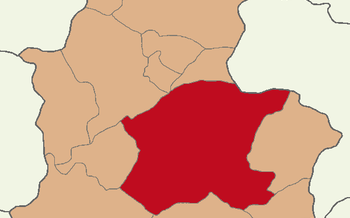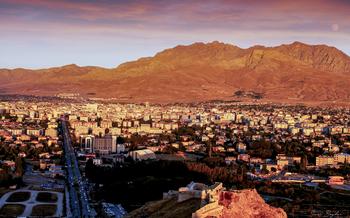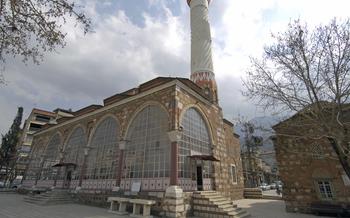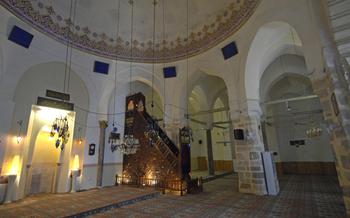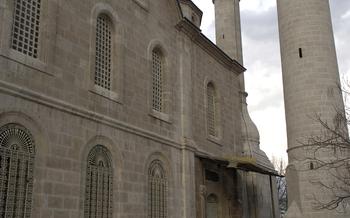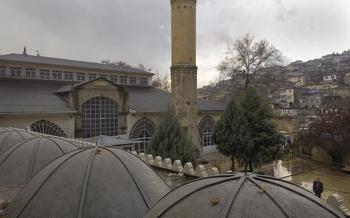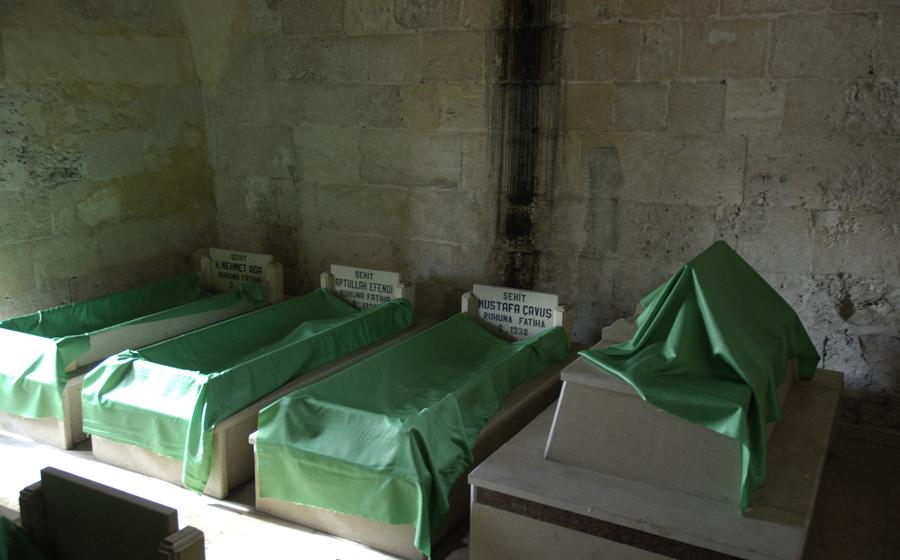
Taş Medrese
- The Antiquity of Taş Medrese
- Architectural Marvel
- Exploring the Courtyard
- The Prayer Hall
- Classroom Experience
- Student Life
- Prominent Scholars of Taş Medrese
- The Legacy of Taş Medrese
- Restoration and Preservation: Rejuvenating a Legacy
- Visiting Taş Medrese
- Surrounding Attractions
- Local Cuisine
- Accommodation Options
- Insider Tip: Unveiling the Hidden Gem of Taş Medrese
The Antiquity of Taş Medrese
Taş Medrese stands as a testament to the rich cultural and historical heritage of Kahramanmaraş. Built in the 15th century during the reign of the Dulkadiroğulları dynasty, the medrese has played a pivotal role in the intellectual and spiritual development of the region. Its construction was commissioned by the governor of Dulkadiroğlu, Halil Bey, who sought to establish a center of Islamic learning that would rival the prestigious madrasahs of Damascus and Cairo.
Taş Medrese is a remarkable example of Seljuk architecture, blending traditional Anatolian motifs with the grandeur of Islamic design. Its name, which translates to "Stone Madrasah," is a nod to the extensive use of stone in its construction, a testament to its durability and resilience over the centuries.
As a center of Islamic learning, Taş Medrese attracted scholars and students from across the region, who flocked to its hallowed halls to pursue knowledge and enlightenment. Its curriculum encompassed a wide range of subjects, including Islamic law, theology, philosophy, and the natural sciences, reflecting the holistic approach to education that was prevalent in Islamic madrasahs.
Taş Medrese has witnessed countless stories and anecdotes over the centuries, adding to its rich tapestry of history. One notable tale speaks of a young scholar named Ahmet, who traveled from a distant land to study at the medrese. Through his dedication and perseverance, he became a renowned scholar and eventually succeeded his mentor as the head of the madrasah, leaving an enduring legacy of knowledge and wisdom.
Architectural Marvel
Taş Medrese stands as a testament to the ingenuity and artistry of Seljuk and Ottoman architects. Its unique design seamlessly blends elements from both architectural traditions, creating a harmonious and visually stunning masterpiece. The medrese's exterior is adorned with intricate carvings, geometric patterns, and decorative motifs, showcasing the exceptional craftsmanship of its builders.
One of the most striking features of Taş Medrese is its imposing entrance portal, intricately carved with verses from the Quran and elaborate floral designs. The portal leads into a spacious courtyard, surrounded by arcades and iwans supported by slender columns. The courtyard's central feature is a beautiful fountain, which adds to the tranquil and serene atmosphere of the space.
Inside the medrese, visitors can marvel at the grandeur of the prayer hall, adorned with a magnificent mihrab (prayer niche) and minbar (pulpit). The mihrab is intricately decorated with colorful tiles, calligraphy, and carvings, creating a focal point for prayer and contemplation. The minbar, crafted from finely carved wood, is a testament to the skill and artistry of the medrese's craftsmen.
Taş Medrese's architectural significance extends beyond its aesthetic beauty. The medrese's design reflects the principles of Islamic architecture, with its emphasis on symmetry, geometric patterns, and the use of natural light. The medrese's layout and orientation were carefully planned to create a harmonious and functional space that facilitated teaching, learning, and spiritual growth.
The architectural marvel of Taş Medrese continues to inspire awe and admiration among visitors from around the world. Its unique blend of Seljuk and Ottoman architectural styles, intricate carvings, and serene atmosphere make it a must-visit destination for anyone interested in Islamic architecture and history.
Exploring the Courtyard
At the heart of Taş Medrese lies a serene and spacious courtyard, serving as a tranquil gathering place for students and scholars throughout history. Surrounded by elegant arcades and graceful iwans, the courtyard exudes a peaceful ambiance that invites contemplation and reflection. Its serene atmosphere and captivating architectural details make it an ideal spot for visitors to soak in the essence of this historic institution.
The central courtyard played a crucial role in the daily life of the medrese, serving as a venue for various activities and interactions. Students and scholars would congregate here to engage in discussions, share knowledge, and seek guidance from their teachers. The arcades provided shaded areas for students to study and engage in scholarly pursuits, while the iwans offered sheltered spaces for gatherings and lectures.
Beyond its functional significance, the courtyard of Taş Medrese holds immense aesthetic value. The intricate carvings and decorative elements adorning the arcades and iwans create a visually captivating spectacle that showcases the artistic prowess of the Seljuk and Ottoman artisans. The courtyard's harmonious blend of architectural styles and its serene atmosphere make it a true gem of Islamic architecture and a must-see for anyone visiting Taş Medrese.
The Prayer Hall
Within the hallowed walls of Taş Medrese lies a sanctuary of worship, a space adorned with intricate details that evoke a sense of awe and spirituality. This is the prayer hall, a testament to the grandeur and devotion that permeated the lives of those who sought knowledge within these ancient walls.
As visitors step into the prayer hall, their gaze is immediately drawn to the mihrab, a niche in the wall indicating the direction of Mecca, the holiest city in Islam. Its intricate carvings, a symphony of geometric patterns and vegetal motifs, frame the sacred space, creating a focal point for the faithful to direct their prayers.
Complementing the mihrab is the minbar, a raised platform from which sermons and religious teachings were delivered. Its elegant design, adorned with delicate carvings and inlaid with precious stones, speaks to the reverence accorded to the spoken word in Islamic tradition.
The walls of the prayer hall are adorned with beautiful calligraphy, verses from the Quran inscribed in flowing Arabic script. These inscriptions, a testament to the artistry and devotion of the medrese's scribes, serve as a constant reminder of the divine teachings that permeated every aspect of life within these walls.
The floor of the prayer hall is covered in intricate tilework, each tile a unique masterpiece of geometric patterns and vibrant colors. These tiles, often featuring verses from the Quran or the names of Allah and the Prophet Muhammad, create a mesmerizing tapestry that invites contemplation and serenity.
The prayer hall of Taş Medrese stands as a testament to the deep spirituality and unwavering faith that characterized the scholars and students who once graced its hallowed halls. Its intricate details and serene atmosphere transport visitors to a realm of devotion and reverence, offering a glimpse into the profound religious traditions that have shaped the history and culture of this ancient land.
Classroom Experience
The classrooms of Taş Medrese, known as "dershane," were the heart of the learning process. Each classroom was dedicated to a specific subject, such as Islamic law, theology, philosophy, or Arabic language. The classrooms were simple yet functional, with low platforms or benches for students to sit on and a central lectern for the teacher.
The teaching methods employed in the medrese were traditional and effective. The teachers, known as "muderris," were highly knowledgeable scholars who lectured on various subjects, often using a Socratic method to engage students in discussions and critical thinking. Students were encouraged to ask questions, participate in debates, and challenge the teacher's ideas.
The subjects taught at Taş Medrese were comprehensive and covered various aspects of Islamic knowledge. Students studied Islamic law (fiqh), theology (kalam), philosophy (falsafa), logic (mantiq), Arabic language (lugha), and exegesis of the Quran (tafsir). They also learned about history, geography, and mathematics.
The legacy of Taş Medrese's educational system is immense. The medrese produced generations of well-rounded scholars who made significant contributions to various fields of knowledge. The emphasis on critical thinking, problem-solving, and intellectual inquiry prepared students for leadership roles in society, whether in religious, political, or academic spheres.
Student Life
The daily life of students at Taş Medrese was regimented and disciplined, revolving around the pursuit of Islamic knowledge and personal development. Their days began with the call to prayer at dawn, followed by morning prayers in the grand prayer hall. After breakfast, they attended lectures and discussions with their teachers, delving into the intricacies of Islamic law, theology, and philosophy. The medrese's courtyard served as a vibrant gathering place for students, where they engaged in lively debates, exchanged ideas, and formed lasting bonds of friendship and camaraderie.
Meals at Taş Medrese were simple but nutritious, typically consisting of traditional Turkish dishes prepared with fresh local ingredients. Students lived in modest dormitories within the medrese complex, where they shared communal spaces and forged close relationships with their peers. Evenings were devoted to personal study and contemplation, as the students immersed themselves in the vast collection of books and manuscripts housed in the medrese's library. The tranquil ambiance of the courtyard provided an ideal setting for reflection and spiritual growth, fostering a sense of community among the students as they strived to become beacons of Islamic knowledge and piety.
Prominent Scholars of Taş Medrese
Taş Medrese has been graced by a multitude of renowned scholars who have contributed significantly to the advancement of Islamic knowledge and thought. Among them, Şeyh Abdurrahman es-Sülemî stands out as a towering figure. As a prolific writer and theologian, he authored over 500 works encompassing various Islamic disciplines, including law, theology, and spirituality. His writings have profoundly influenced Islamic thought and continue to be studied by scholars worldwide.
Another notable scholar associated with Taş Medrese is Şeyh Muhyiddin el-Arabi, a prominent figure in Islamic mysticism and philosophy. His seminal work, "Fusus al-Hikam," remains a foundational text in Islamic thought, exploring the unity of existence and the relationship between God and creation. His teachings have had a profound impact on subsequent generations of Islamic thinkers and mystics.
Şeyh Sadreddin el-Konyevî, a distinguished philosopher and mystic, also graced the halls of Taş Medrese. His writings on metaphysics, ethics, and mysticism have earned him a prominent place in Islamic intellectual history. His work, "Keykulbedî," is regarded as a masterpiece of Islamic philosophy, delving into the nature of reality and the human soul.
These are just a few examples of the many eminent scholars who have adorned Taş Medrese throughout its illustrious history. Their contributions to Islamic scholarship and thought have left an indelible mark on the intellectual and spiritual landscape of the Muslim world.
The Legacy of Taş Medrese
Taş Medrese's legacy as a hub of Islamic learning endures to this day. Over the centuries, the medrese has played a pivotal role in shaping the intellectual and spiritual development of Kahramanmaraş and the surrounding region. Its teachings and graduates have profoundly impacted the development of Islamic law, theology, and philosophy.
The medrese's influence can be traced in the writings and teachings of its renowned alumni, who went on to become prominent scholars and leaders in their respective fields. Their contributions to Islamic thought and scholarship have left an indelible mark on the development of Islamic civilization.
Taş Medrese's legacy extends beyond its walls, as it has served as a model for other Islamic educational institutions. Its unique blend of architectural design, educational methodology, and scholarly achievements has inspired the establishment of similar institutions across the Islamic world.
The medrese's enduring legacy is a testament to its profound impact on Islamic scholarship and thought. Its contributions to the preservation and transmission of Islamic knowledge continue to resonate throughout the Muslim world, ensuring its place as a revered center of Islamic learning for generations to come.
Restoration and Preservation: Rejuvenating a Legacy
Over the years, Taş Medrese faced the inevitable ravages of time and neglect. Recognizing its immense historical and cultural significance, authorities undertook a meticulous restoration project to revive its former glory. This endeavor required careful attention to detail, using traditional techniques and materials to maintain the authenticity of the medrese's architectural heritage.
The restoration process presented several challenges. One of the primary concerns was preserving the integrity of the original structure while addressing necessary repairs and improvements. Skilled artisans and craftsmen worked diligently to restore intricate carvings, mend damaged tiles, and reinforce weakened foundations. The project also involved modernizing certain aspects of the medrese, such as installing lighting and climate control systems, while ensuring that these additions blended seamlessly with the historical fabric of the building.
The restoration of Taş Medrese serves as a testament to the enduring value of cultural heritage and the importance of preserving such landmarks for future generations. Through meticulous restoration efforts, this architectural masterpiece has been revitalized, allowing visitors to experience its splendor and learn about its rich history.
Visiting Taş Medrese
Practical Information for an Enriching Experience:
Before embarking on your journey to Taş Medrese, it's essential to plan your visit to make the most of this historical and cultural gem. Here are some practical tips to ensure a smooth and enjoyable experience:
-
Opening Hours and Admission Fees: Taş Medrese is generally open to visitors from 9 am to 5 pm, seven days a week. The admission fee is nominal, allowing everyone to experience its grandeur without breaking the bank.
-
Guided Tours: Enhance your visit by opting for a guided tour, which provides valuable insights into the history, architecture, and significance of Taş Medrese. Guided tours are available in multiple languages, ensuring that visitors from all over the world can appreciate the wonders of this ancient institution.
-
Tips for a Fulfilling Visit: To fully immerse yourself in the atmosphere of Taş Medrese, allow ample time to explore its various sections, including the courtyard, prayer hall, classrooms, and library. Take your time to admire the intricate details, soak in the peaceful ambiance, and let the history of this place transport you back in time.
-
Best Time to Visit: The best time to visit Taş Medrese is during the shoulder seasons (spring and autumn) when the weather is pleasant, and the crowds are smaller. This allows for a more intimate and serene experience, allowing you to fully appreciate the beauty and tranquility of this architectural masterpiece.
Surrounding Attractions
Taş Medrese is not the only historical and cultural treasure in Kahramanmaraş. The city is home to a wealth of other attractions that are worth exploring. For history buffs, the Kahramanmaraş Museum is a must-visit, showcasing artifacts and exhibits that tell the story of the city's rich past. The Grand Mosque of Kahramanmaraş is another architectural marvel, with its stunning domes and minarets. Nature lovers can escape the city's hustle and bustle at the Menzelet Forest, a picturesque spot perfect for picnics and hiking.
To create a comprehensive itinerary, consider combining your visit to Taş Medrese with other attractions in the city. Start your day by exploring the medrese, then head to the Kahramanmaraş Museum to delve deeper into the city's history. In the afternoon, visit the Grand Mosque and marvel at its architectural grandeur. End your day with a peaceful stroll through the Menzelet Forest, soaking in the beauty of nature.
Kahramanmaraş is well-connected by public transportation, making it easy to get around the city. Buses and taxis are readily available, and there are several car rental agencies for those who prefer the flexibility of having their own vehicle.
Local Cuisine
Kahramanmaraş is renowned for its distinctive cuisine, which reflects the region's rich history and culture. Visitors to Taş Medrese can indulge in a culinary journey by sampling the city's delectable dishes.
Must-Try Local Dishes:
-
Maraş Dondurması: This world-famous ice cream is a must-try for any visitor to Kahramanmaraş. Made with goat's milk and mastic gum, it is known for its unique texture and flavor.
-
Sütlü Köfte: These meatballs made with ground beef and bulgur are simmered in a flavorful tomato sauce.
-
Ekşili Çorba: A tangy and refreshing soup made with yogurt, wheat flour, and herbs, Ekşili Çorba is a local favorite.
-
Pöç Kebabı: Slow-cooked lamb shanks in a flavorful broth, served with bulgur pilaf.
-
Katmer: A crispy pastry filled with cheese, nuts, and honey, Katmer is a popular dessert in Kahramanmaraş.
Famous Restaurants and Eateries:
-
Cigerci Ali: Renowned for its delicious grilled lamb liver dishes.
-
Konyalı Et Lokantası: Offers a wide range of traditional Turkish kebabs and stews.
-
Mardinli Ahmet Usta: Specializes in regional dishes, including Sütlü Köfte and Ekşili Çorba.
-
Dondurmacı Ali Usta: A must-visit for Maraş Dondurması enthusiasts.
-
Katmerli Mehmet Usta: Known for its crispy and flavorful Katmer.
Tips for Finding Authentic Turkish Food:
-
Venture off the beaten path and explore local markets and small eateries.
-
Ask locals for their recommendations for authentic restaurants.
-
Look for establishments that use fresh, local ingredients.
-
Don't be afraid to try new dishes and flavors.
-
Enjoy the communal dining experience by sharing dishes with friends and family.
Accommodation Options
To fully immerse yourself in the local culture, consider staying at a traditional Turkish guesthouse. These guesthouses often offer a more authentic experience, allowing you to interact with locals and learn about their way of life. The guesthouses near Taş Medrese exude charm and character, and some even offer rooftop terraces with stunning views of the city.
For a more comfortable stay, there are several hotels in the vicinity that cater to different budgets and preferences. Online booking platforms like Booking.com or Airbnb provide a convenient way to compare prices, read reviews, and book your accommodation in advance.
Here are a few recommendations to get you started:
-
For a luxurious stay: The Divan Kahramanmaraş Hotel offers modern amenities, a spa, and a fitness center.
-
For a mid-range option: The Best Western Plus Kahramanmaraş Hotel provides comfortable rooms and a hearty breakfast.
-
For budget travelers: The Kahramanmaraş Hostel offers affordable dorm rooms and a friendly atmosphere.
No matter where you choose to stay, the warm hospitality of the locals will make you feel right at home.
Insider Tip: Unveiling the Hidden Gem of Taş Medrese
Beyond the main attractions of Taş Medrese, visitors seeking a unique experience should venture to the hidden gem nestled within its walls. As you wander through the serene courtyard, keep an eye out for an unassuming doorway tucked away in a corner. This inconspicuous entrance leads to a secret chamber, once used as a treasury to safeguard precious books and manuscripts. The dimly lit room exudes an aura of mystery, with shelves adorned with ancient volumes that tell tales of a bygone era. Take a moment to immerse yourself in the tranquility of this hidden chamber, allowing the whispers of history to transport you back in time.
